Abstract
Background:
Indians constitute one of the largest population groups in the world. Facial anthropometry, morphology, and age-related changes in Indians differ from those of other ethnic groups, necessitating a good understanding of their facial structure and the required aesthetic treatment strategies. However, published recommendations specific to Indians are few, particularly regarding combination treatment.
Methods:
The Indian Facial Aesthetics Expert Group (19 dermatologists, plastic surgeons, and aesthetic physicians with a mean 15.5 years’ aesthetic treatment experience) met to develop consensus recommendations for the cosmetic facial use of botulinum toxin and hyaluronic acid fillers, alone and in combination, in Indians. Treatment strategies and dosage recommendations (agreed by ≥ 75% of the group) were based on results of a premeeting survey, peer-reviewed literature, and the experts’ clinical experience.
Results:
The need for combination treatment increases with age. Tear trough deficiency is the most common midface indication in Indian women aged 20–40 years. In older women, malar volume loss and jowls are the most common aesthetic concerns. Excess medial soft tissue on a relatively smaller midface precedes age-related sagging. Hence, in older Indians, fillers should be used peripherally to achieve lift and conservatively in the medial zones to avoid adding bulk medially. The shorter, wider lower face requires 3-dimensional correction, including chin augmentation, to achieve increased facial height and the oval shape desired by most Indian women.
Conclusions:
These recommendations give physicians treating Indians worldwide a better understanding of their unique facial characteristics and provide treatment strategies to achieve optimal aesthetic outcomes.
INTRODUCTION
Indians constitute one of the largest population groups in the world, and they contributed significantly to Asians being the fastest growing ethnic group in the United States between 2000 and 2010.1 As the global population becomes more diverse, aesthetic physicians worldwide commonly treat people from many ethnic groups, including Indians.
Although some aspects of facial beauty are universal,2,3 aesthetic preferences also vary among ethnic groups and cultures because cosmetic concerns differ according to variations in facial bony anatomy, morphology, and skin tones, both in the relatively young and during aging.2 Several anthropometric features of Indian faces differ significantly from those of Caucasians (Table 1) and Southeast Asians.4 The total facial height among Indians is generally less than that of age-matched Caucasians; they have a significantly shorter and narrower midface and greater bi-ocular width than Caucasians.4–7 Indians’ foreheads contribute a greater proportion of their face height and the lower facial third is proportionally shorter than that of Caucasians.5 The lower face width of Indians is greater than Caucasians’, but less than Southeast Asians’.4 Indians’ nasal length is greater than Asians’ and less than Caucasians’; the nasal width is greater than Caucasians’, but less than those of Asians and African Americans.4 Indians also have a more convex profile than Caucasians and Southeast Asians.8 In general, Indian women prefer an oval face with adequate soft-tissue fullness.9,10
Table 1.
Facial Anthropometry and Related Physical Characteristics/Appearance of the Indian Face
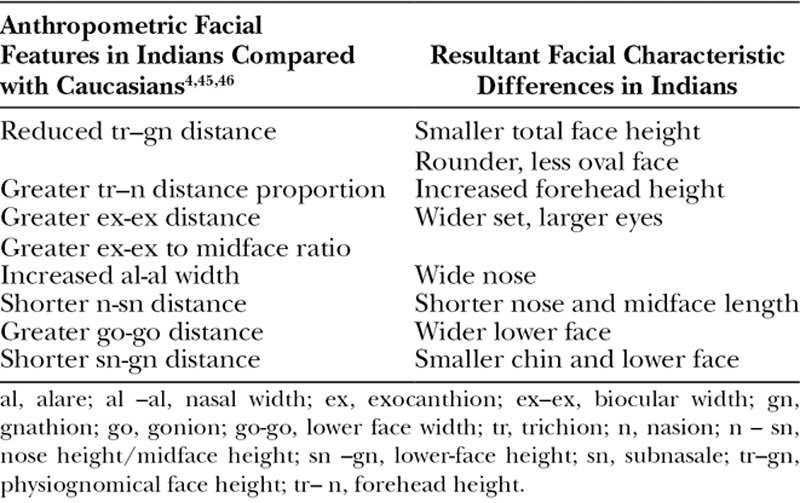
Even though the physiological aging process may be similar among ethnic groups, many Indian facial anatomical characteristics lead to unique manifestations of facial aging. The increased pigment in Indian skin protects against photo damage, so that lines and wrinkles do not appear as early as in Caucasians.11,12 However, downward and medial shifting of the deep fat compartments, along with volume loss, leads to sagging of the thicker soft tissue on a smaller bony framework, making Indians more prone to folds than lines in middle age. Indians are also particularly prone to developing periorbital hyperpigmentation13 and infraorbital hollowing or “tear trough deformity” at a relatively young age.
The structural and morphological features specific to the Indian face, and differences from Western and Asian populations in skin and soft-tissue aging, necessitate well-defined aesthetic treatment strategies for Indians. This is also applicable to Indians globally and not just those residing in India, who will have the same unique facial shape and features specific to Indians. However, their aesthetic sensibilities may be influenced by the trends in the country they are currently living in. However, published recommendations and clinical evidence for facial injectable treatments in Indians, particularly combination treatment, are few. A search of PubMed using the terms “filler + face/facial + India/Indian” and “botulinum + face/facial + India/Indian” revealed 24 articles concerned with facial rejuvenation, after omitting those that focused on hyperhidrosis, ophthalmic applications, and dentistry.5,9,14–35 Despite the increasing popularity of combination treatment with botulinum toxin and hyaluronic acid (HA) fillers worldwide,2,36 few articles describe their combination use in Indians in any detail.21,26,31 In the guidelines on botulinum toxin33 and filler32 use published previously by other Indian authors, recommendations aimed at Caucasians were often referenced.21
To address this knowledge gap, the Indian Facial Aesthetics Expert Group (IFAEG) met to develop consensus opinions on the use of botulinum toxin and HA fillers for facial rejuvenation. The objectives were to (1) discuss the unique aspects of Indian facial structure and aging; (2) identify Indians’ aesthetic concerns; (3) understand current local practices regarding facial injectable treatments in India; and (4) develop consensus opinions and recommendations on facial treatment with injectable agents in Indians. These recommendations are intended to provide guidance to aesthetic physicians all over the world who treat Indians for cosmetic facial indications. India is a large country, and there are variations in facial shape and features based on the geographical location, but it is beyond the scope of this article to provide recommendations for each subgroup.
METHODS
The IFAEG comprises 19 experts in facial aesthetic procedures (2 plastic surgeons, 14 dermatologists, and 4 aesthetic physicians) who have at least 8 years of experience and are trainers in the use of facial injectable aesthetic treatments in India (mean, 15.5 years’ experience in facial aesthetics; range, 8–25 years). Although people in neighboring countries like Pakistan and Bangladesh may have similar facial features as Indians, this study provides recommendations to treat only Indian faces as all the participating physicians practice in India. The IFAEG members were asked to complete a premeeting online survey via SurveyMonkey (surveymonkey.com) like the one described previously.2 The aim of the survey was to identify their Indian patients’ most common aesthetic concerns and the most commonly used facial injectable treatments in Indians by age group, as well as to determine these experts’ dose/volume ranges and practice patterns when using botulinum toxin and HA fillers to treat various facial aesthetic indications.
The IFAEG then met to develop consensus-based recommendations for the aesthetic use of botulinum toxin and HA fillers in Indians, based on the premeeting survey results, peer-reviewed literature (where available), and members’ own clinical experience. Consensus was defined as agreement among 75% (15/19) or more of the meeting participants. The injection points and dose ranges for botulinum toxin, and the preferred HA filler products, plane of injection and volume ranges presented here, were agreed by ≥ 75% of participants. Preferred filler products and volumes presented here pertain to Juvéderm’s (Allergan, Inc., Irvine, Calif.) range of HA fillers as these were the most commonly used by all members of the group. Onabotulinum toxin A (Botox Cosmetic, Allergan, Inc., Irvine, Calif.) units are specified for botulinum toxin dose ranges as it is the most commonly used toxin in the country. As the target muscles for each indication of botulinum toxin treatment remain the same and are already well described in the literature,37,38 they have not been tabulated here.
RESULTS
Survey Outcomes Regarding Aesthetic Concerns and Current Treatment Patterns
Seventeen experts completed the premeeting survey. Indian women’s most common aesthetic concerns are shown by age in Table 2. Infraorbital hollow, also known as tear trough deficiency or nasojugal groove,39 is the most common aesthetic concern among Indian women aged 20–40 years. This may be due to a retruded maxilla and loss of subcutaneous fat, which is further accentuated by the presence of periorbital hyperpigmentation.24 There is a paucity of literature regarding the aetiology of the increased incidence of tear trough in Indians, although 1 study showed that the most common cause of periorbital hyperpigmentation in Indians was vascular, followed by constitutional and then shadow effects.13 Lip augmentation is the second most common aesthetic requirement in 20–30-year-old Indians (Table 2). Physicians notice chin projection inadequacy in this age group, most probably due to the shorter and wider lower face in relation to Indians’ overall facial height and due to mandibular retrusion.4,6
Table 2.
Premeeting IFAEG Survey Results: Indian Women’s Most Common Aesthetic Concerns by Age According to Physicians’ and Patients’ Opinions (17 Responses)

As Indian women reach the age of 30–40 years, they present with nasolabial folds, which their physicians understand can be corrected by addressing malar volume loss. Upper facial lines are a less frequently requested treatment due to protection from photoaging afforded by the skin pigment. After the age of 55 years, Indians most commonly present for treatment of jowls and marionette folds, followed by neck skin laxity (Table 2).
HA fillers are the most commonly used facial injectable treatment in 20–30-year-old Indians (Table 3). Botulinum toxin for issues other than facial lines and combination treatment are the next most common treatments used in this age group. Combination treatment with botulinum toxin and HA fillers is the most common treatment strategy used by IFAEG members in Indians aged over 30 years. Botulinum toxin for facial lines is the third most common indication for Indians, even in middle age, because superficial wrinkling appears later in life.
Table 3.
Premeeting IFAEG Survey Results: Most Commonly Used Facial Injectable Treatments by Patient Age (17 Responses)

Consensus Recommendations and Opinions on Facial Injectable Treatment Strategies in Indians
The premeeting survey showed that treatment patterns with botulinum toxin and HA fillers vary among IFAEG members within indications (Fig. 1). They agreed that this is due to the variety of their patients’ aesthetic concerns, needs, age and facial anatomy/characteristics, and the physicians’ own preferences. Nevertheless, combination treatment with botulinum toxin and HA fillers is used by majority of these physicians to treat many indications in the upper, mid, and lower face (Figs. 1, 2).
Fig. 1.
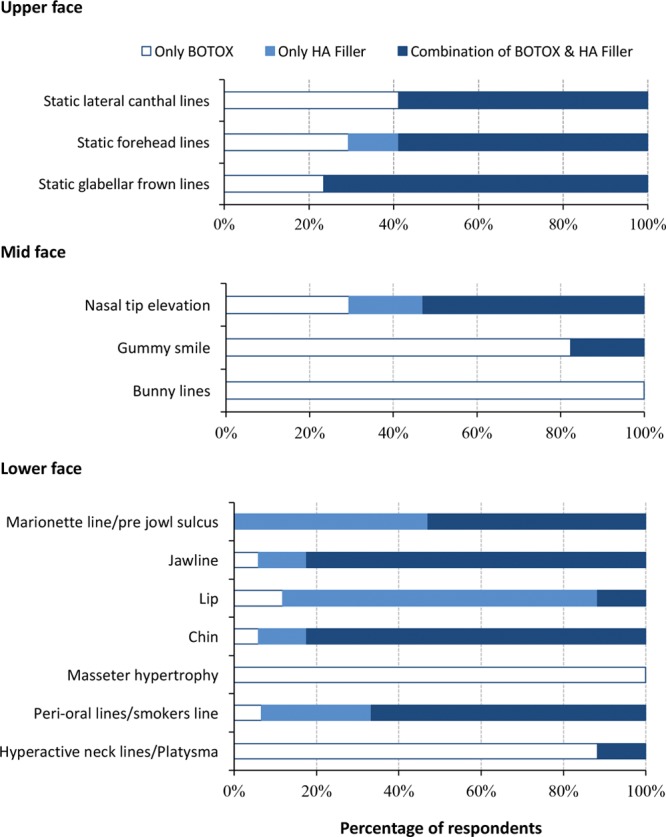
Facial injectable treatments used by IFAEG members for their Indian facial aesthetic patients: results of a premeeting survey completed by 17 experts.
Fig. 2.
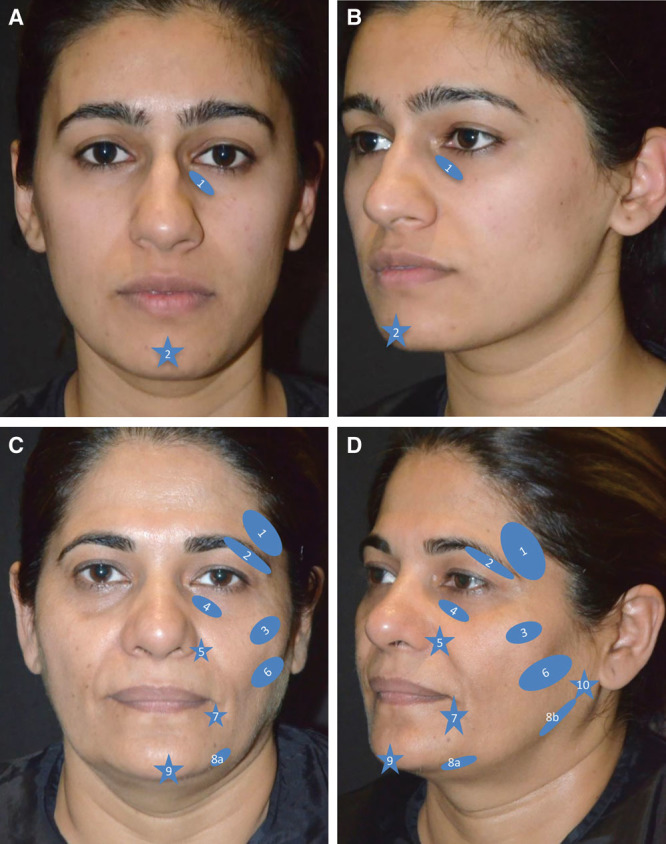
Zones commonly treated with a combination of HA filler plus botulinum toxin in younger (A and B) and older (C and D) Indian women. A and B: 1, Tear trough; 2, Chin. C and D: 1, Temporal fossa; 2, Lateral supraorbital region; 3, Temporal process of zygomatic bone; 4, Tear trough; 5, Nasal ala; 6, Buccal deficit; 7, Marionette triangle; 8A, Prejowl sulcus; 8B, Postjowl sulcus; 9, Chin; 10, Angle of mandible. (Courtesy of Dr Chiranjiv Chhabra)
Use of Combination Treatment
The IFAEG agreed that the aim of combination treatment with botulinum toxin and HA fillers is to achieve optimal aesthetic outcomes in keeping with the ethnic considerations specific to an Indian face. Using combination treatment results in more natural-looking, aesthetically harmonious outcomes, with the added advantage of prolonging the duration of these outcomes.36,38 Combination treatment is also required to address multiple age-related aesthetic concerns (Fig. 2)33,36 and leads to high levels of patient satisfaction.36 An individualized, integrated approach to assessing and treating the full face is advised because treating a single facial area may lead to unbalanced or suboptimal results.36,38,40
When administering combination treatment, botulinum toxin should ideally be injected first because relaxation of the facial muscles allows the HA fillers injected subsequently to disperse more easily, potentially reducing the amount required and improving the durability of their effect.36 Although the experts agreed that treating with botulinum toxin and fillers at separate visits (separated by approximately 2 weeks) is preferable in terms of outcome,26,31 this may not always be possible (for example, if the patient has travel or time constraints). When combination treatment is carried out during a single visit, HA fillers should be injected before the botulinum toxin, so that toxin does not disperse beyond the area under the target muscles when the skin is massaged after filler administration.
Upper Face
The consensus recommendations for HA filler and botulinum toxin use in Indians for upper face indications, based on the IFAEG members’ own clinical experience, are presented in Table 4 and Figure 2.
Table 4.
Consensus Recommendations and IFAEG Opinions Regarding Injectable Treatment of Upper Face Indications in Indians
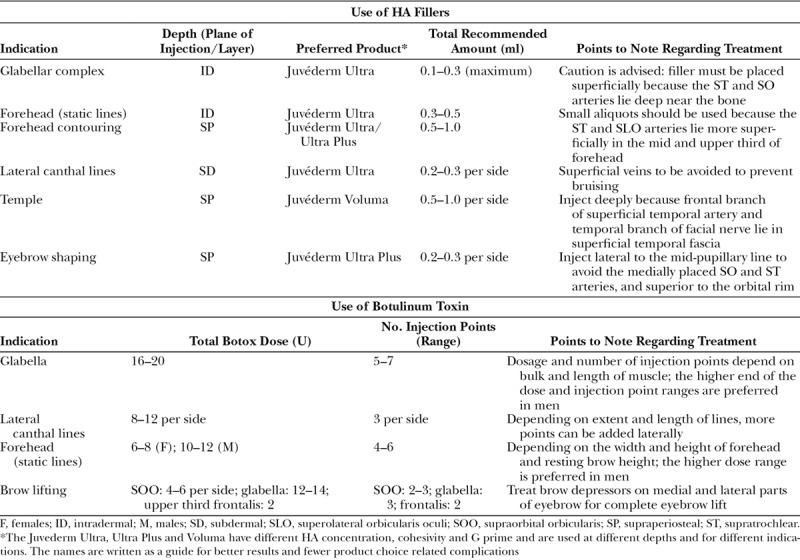
When the experts were asked in the premeeting survey what proportion of their patients who present for facial rejuvenation are treated for volume deficits in the upper face with HA filler, the mean responses were as follows: temple 37%, eyebrow shaping 27%, forehead contouring 18%, and glabellar complex 16%. Asked what was the most commonly requested indication for upper facial lines in their practices, 41% stated that the most common requests are for treatment of all 3 indications: glabella, forehead, and lateral canthal lines; 35% of respondents’ most commonly requested indication is for glabella and forehead lines, and 17% are for lateral canthal lines and glabella lines.
In these experts’ opinion, botulinum toxin is the preferred treatment for upper facial lines if they occur in 20–40-year-old Indians, while combination treatment is preferred for static lines in older patients (Table 3; Fig. 1). Lateral canthal lines are not commonly treated with fillers in Indians because they are not as deep in Indians as in Caucasians. Indian skin is thicker and photoaging is delayed, so smaller amounts of botulinum toxin yield good results and combination treatment with fillers is less often required in this area.41 For the glabellar area, a combination of botulinum toxin with fillers is most commonly used in Indians to achieve maximal effect (Fig. 1).
Indians require smaller volumes of fillers for forehead contouring than Asians42 as their forehead makes up a larger proportion of their facial height and is mostly well projected. They also require less botulinum toxin to treat forehead lines and corrugators than Caucasians38,41 because delayed photoaging results in fewer facial lines. The experts also agreed that Indians prefer a natural appearance in the upper face, further reducing the amount of toxin and filler needed. However, the botulinum toxin dosage required to treat upper static forehead lines is higher in men than women (Table 4), in agreement with other findings in Indians.21,22,33
Indian women prefer a high arched brow, with no lateral flare21; hence, for a brow lift with an arch, the medial frontalis is treated in addition to the brow depressors to achieve the desired eyebrow shape.
Midface
IFAEG members’ consensus recommendations for HA filler and botulinum toxin use for midface indications based on their own clinical experiences are presented in Table 5 and Figure 2.
Table 5.
Consensus Recommendations and IFAEG Opinions Regarding Injectable Treatment of Midface Indications in Indians
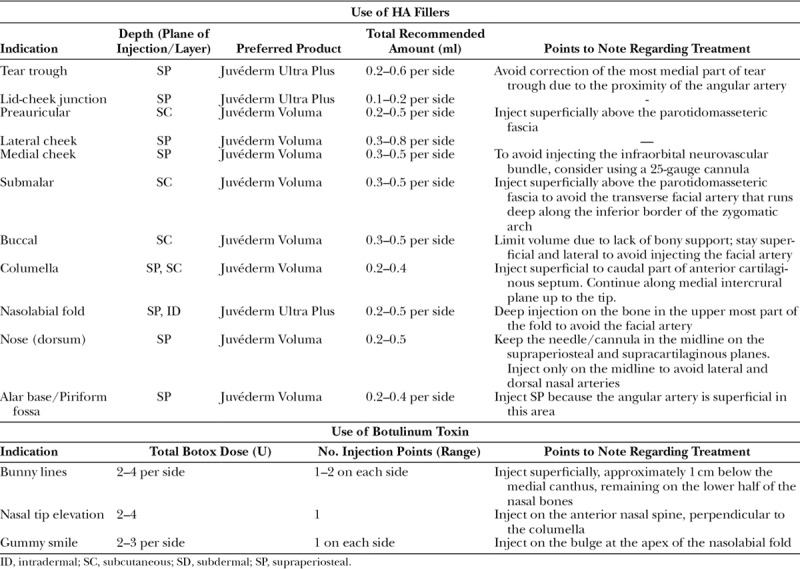
Tear trough deficiency is a very common aesthetic concern in Indians, even at a young age (Table 2). Indians aged 20–30 years who present with tear trough deficiency mostly require treatment of the medial hollowness. However, older Indians can also be treated with fillers at the lid-cheek junction to counteract loss of lateral suborbicularis oculi fat that occurs as part of the aging process. Correcting the medial suborbicularis oculi fat in the first instance addresses much of the tear trough deficiency in younger patients, reducing the amount of filler needed in the actual tear trough, but the volume loss experienced by older people requires additional deep malar fat pad correction to lift the cheek. Under-correction in this area is preferred because of the excess soft tissue below this area that is responsible for the relative fullness of Indian faces.9
Even though Indians have a structurally smaller and narrower midface, the presence of excess soft tissue in the medial part of the face means that restoration of age-associated volume deficit is mostly required in the lateral part of the midface.5 The lateral cheek is treated with fillers to contour cheeks in younger patients and to restore age-related volume deficits in older patients. Fillers injected into the lateral cheek create lift, reduce the appearance of nasolabial folds, and can reduce the appearance of the malar groove that results when the zygomatic malar ligament causes indentation of the lax lateral cheek at the lower border of the malar mound/festoon. To correct a malar groove, filler should be injected into the groove using a layering technique, starting supraperiosteally and then more superficially in the deep dermis. Care should be taken not to inject above the groove as it would make the malar mound more prominent. Injection in the vicinity of the malar mound should be supraperiosteal or just subdermal to avoid the lymphatic vessels in the subcutaneous plane.43
When treating nasolabial folds in Indians, the IFAEG recommended that addressing the lateral vectors and treating the lateral cheek area to achieve cheek lift should be done first. Any residual nasolabial fold should be filled at a later stage if required, because excessive filler correction of the nasolabial fold will add to the existing soft-tissue bulk observed medially in the Indian face and will lead to greater central bulk.5 For the same reasons, fillers should be used conservatively while treating the medial cheek in Indians. Similarly, filling the preauricular area with the appropriate volume of fillers decreases the appearance of jowls and marionette lines so that less filler is required in the actual lines and prejowl sulcus.44
In Indians, the nasal width (inter-alar distance) is often greater than that of Caucasians.4 This contributes to less nasal tip projection and a wider alar base on an already narrow midface, giving the Indian nose a wider appearance. A wide alar span in Indians can be corrected with filler injections in the alar base/piriform fossa to narrow the base of the nose, and in the columella as a bolus on the anterior nasal spine and as a pillar to support the tip. In general, filler in the nasal dorsum of Indians is used mainly in low volumes to camouflage a hump, correct supratip deformity, or to augment low-profile noses or a recessed radix. Nonsurgical correction for a drooping/less projected nasal tip with botulinum toxin in the depressor septi muscle is also very effective in Indians.
For bunny lines, botulinum toxin is used to treat the recruitment of the nasalis muscle that occurs after injection of brow depressors and orbicularis oculi.33 Gummy smile in Indians can be effectively treated with botulinum toxin.20
Lower Face
IFAEG members’ consensus recommendations for HA filler and botulinum toxin use for lower face indications in Indians, based on their own clinical experience, are presented in Table 6 and Figure 2.
Table 6.
Consensus Recommendations and IFAEG Opinions Regarding Injectable Treatment of Lower-Face Indications in Indians
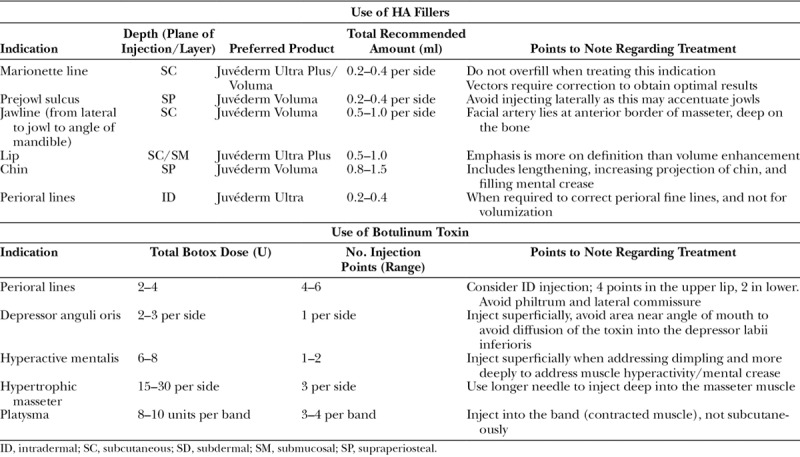
Marionette lines and prejowl sulcus tend to develop due to ligamentous laxity and bone loss, and the IFAEG members agreed that they tend to appear early in Indians due to their relatively smaller lower facial framework. In younger Indians, marionette lines can be treated as an individual indication. In older people, because the appearance of jowls and marionette lines results largely from loss of volume in the lateral mid and lower face, these areas should be corrected first,44 followed by filling of the prejowl sulcus itself. An aesthetically pleasing outcome can then be achieved by injecting filler directly into any residual marionette lines.
The proportionally smaller, wider lower face in Indians and their shorter chin4,45,46 gives rise to a more rounded facial shape. The retruded chin often observed in Indians commonly results in mentalis hyperactivity and hypertrophy. The most common use of filler in the lower face of Indians is in combination with botulinum toxin for chin enhancement and jawline correction (Fig. 1). Masseter hypertrophy, though less common in Indians than in Asians, contributes to lower face width in Indians, and botulinum toxin treatment can help to narrow the lower face.16 Before treating the masseters, it is important to distinguish between the different causes of increased facial width (ie, eversion of bony angle of the mandible, masseter hypertrophy, parotid hypertrophy, or fat). Aggressive treatment of masseters with high doses of botulinum toxin should be avoided in older Indians as it can exacerbate the signs of facial aging through increased cheek hollowness and jowl formation due to the lack of muscular support.
Indians’ lips generally have good volume and projection; hence volumization is not often required. The IFAEG members agreed that definition is more sought after than volume in younger patients, and in older patients, age-related atrophic changes are corrected.18
In the opinion of these experts, perioral lines are less commonly observed in Indians than in Caucasians, most likely due to their greater lip volume, thicker skin and delayed photoaging, and only require treatment in older Indians.
SUMMARY AND CONCLUSIONS
Facial aging is a multifactorial process that involves changes in musculoskeletal and soft-tissue structures, among others. Certain morphological aspects of Indian faces differ from those of Asians and Caucasians, as do some aesthetic preferences, indicating a need for unique aesthetic treatment strategies (Table 7). In India, botulinum toxin and HA fillers are used in combination for most facial indications (Fig. 1), as single-treatment modalities are nor adequate to treat many age-related aesthetic concerns, and the aesthetically harmonious outcome preferred by Indians is best achieved by combination treatment (Figs. 3, 4). As published recommendations specific for Indians are few, these consensus recommendations based on the IFAEG members’ clinical experience are the first to address this knowledge gap.
Table 7.
Summary of Treatment Strategies to Address Unique Aspects of Indian Facial Morphology

Fig. 3.
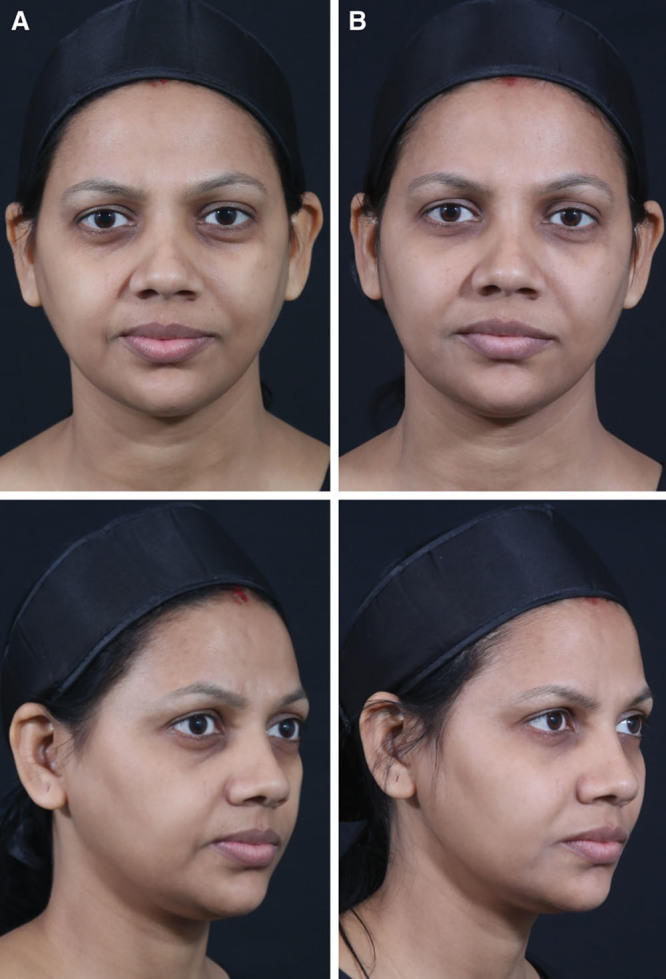
Indian woman before (A) and after (B) full-face combination treatment with botulinum toxin and HA fillers (Courtesy of Dr. Vandana Chatrath). Botox: Glabellar frown lines (15 units), forehead (6 units), lateral eyebrow (8 units), chin (5 units). Juvederm Voluma with lidocaine 2 ml for lateral malar region, cheek apex and chin; Juvederm UltraPlus XC 3 ml for the tear trough, dorsum of nose, lips, mental crease and marionette lines.
Fig. 4.
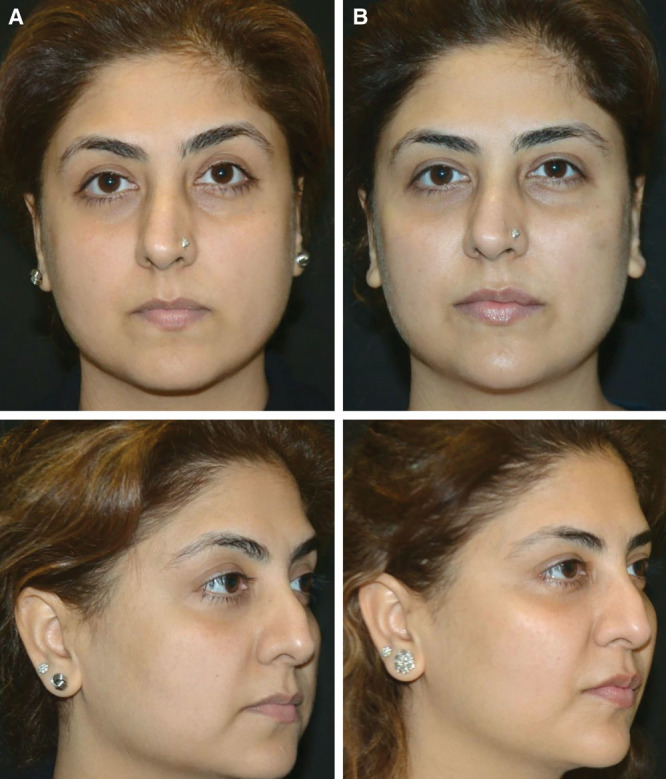
Indian woman before (A) and after (B) full-face combination treatment (1.5 ml Juvederm Voluma with Lidocaine, 2 ml Juvederm Ultra XC and 2.5 ml Juvederm Ultraplus XC for the medial and lateral malar regions, tear trough, chin, lips, and marionette lines; and Botox for crow’s feet (16 units), glabellar frown lines (20 units), horizontal forehead lines (8 units), eyebrow lift (12 units), masseter (40 units), depressor anguli oris (4 units), and chin (6 units). (Courtesy of Dr. Chiranjiv Chhabra).
The premeeting survey showed that temple hollowing is a common upper-face aesthetic concern among Indians. Tear trough deficiency is the most common midface concern in Indian women aged 20–40 years. In older women, facial sagging due to malar volume loss is the most pressing aesthetic concern (Table 2). A structurally smaller midface and relatively excess soft tissue in the medial cheek necessitates that fillers be used in peripheral facial zones to achieve lift, and conservatively in the medial zones to avoid adding bulk here.4,5,45 The shorter and wider lower face requires 3-dimensional correction with volumization of the chin area to achieve increased facial height and the oval shape desired by most Indian women.
In conclusion, a detailed knowledge of the morphological characteristics of the Indian face and the use of botulinum toxin and HA fillers is needed to address Indians’ aesthetic concerns while keeping the ethnic considerations in mind. These recommendations may give physicians treating Indians in any part of the world a better understanding of their unique facial characteristics, and of the treatment strategies required to achieve optimal aesthetic outcomes. At the same time these assessment and treatment guidelines can also help injectors customize the treatment for Indian patients while keeping their individual beauty goals in mind.
ACKNOWLEDGMENTS
The Indian Facial Aesthetics Expert Group also included Mansi Mukerjee, MD; Hema Pant, MD; Simal Soin, MPhil; Jalpa Jani, MD; Falguni Shah, MD; Anuya Manerkar, MD; Anju Methil, MD; Shrilata Trasi, MD; and Jaishree Sharad, DDV.
PATIENT CONSENT
Patients provided written consent for the use of their images.
Footnotes
Disclosure: Dr. Kapoor is a consultant and trainer for Allergan and faculty member of Allergan Medical Institute and has received honoraria and support for training activities and meetings. Dr. Chatrath is a faculty member for Allergan Medical Institute and sits on the advisory board for Allergan, India. Dr. Anand is a faculty member of the Allergan Medical Institute, sits on advisory boards of Allergan, Galderma, and Merz, and is a consultant for Cynosure, Alma, Bioderma Pharmaceuticals, and Beauty IQ LLP. Dr. Chhabra sits on an advisory board for Allergan India and is a faculty member of Allergan Medical Institute, has received honoraria from Allergan for meetings and training, from Merz for attending meetings and delivering lectures and training, and from Fotona for lectures. Dr. Shetty is faculty member of Allergan Medical Institute, sits on the advisory board of Allergan India and has received honoraria for training workshops. Dr. Singh sits on the Advisory Board of Allergan India, is a faculty member of Allergan Medical Institute, and receives honoraria from Allergan India for conducting training, as well as support for travel and accommodation for training meetings. Dr. Vedamurthy is a faculty member of Allergan Medical Institute. Dr. Pai is on the Asia Pacific Advisory Board for Allergan and is a faculty member of Allergan Medical Institute and has received honoraria from Allergan for attending meetings, delivering lectures, and training. Dr. Sthalekar is a faculty member of Allergan Medical Institute. Dr. Sheth is a faculty member of Allergan Medical Institute and has received honoraria for delivering training programmes. The Article Processing Charge was paid for by the authors.
REFERENCES
- 1.United States Census Bureau. The Asian population: 2010. 2012. Available at https://www.census.gov/prod/cen2010/briefs/c2010br-11.pdf. Accessed December 8, 2015.
- 2.Liew S, Wu WT, Chan HH, et al. Consensus on changing trends, attitudes, and concepts of Asian beauty. Aesthetic Plast Surg. 2015:1–9.. [DOI] [PMC free article] [PubMed] [Google Scholar]
- 3.Swift A, Remington K. BeautiPHIcation: a global approach to facial beauty. Clin Plast Surg. 2011;38:347–77, v.. [DOI] [PubMed] [Google Scholar]
- 4.Farkas LG, Katic MJ, Forrest CR, et al. International anthropometric study of facial morphology in various ethnic groups/races. J Craniofac Surg. 2005;16:615–646.. [DOI] [PubMed] [Google Scholar]
- 5.Shetty R. Outer circle versus inner circle: special considerations while rejuvenating an Indian face using fillers. J Cutan Aesthet Surg. 2015;8:169–172.. [DOI] [PMC free article] [PubMed] [Google Scholar]
- 6.Jagadish Chandra H, Ravi MS, Sharma SM, et al. Standards of facial esthetics: an anthropometric study. J Maxillofac Oral Surg. 2012;11:384–389.. [DOI] [PMC free article] [PubMed] [Google Scholar]
- 7.Kalra S, Bagga DK, Poonam A. Evaluation of various anthropometric proportions in Indian beautiful faces: a photographic study. APOS Trends Orthod. 2015;5:190–196.. [Google Scholar]
- 8.Jain P, Kalra JP. Soft tissue cephalometric norms for a North Indian population group using Legan and Burstone analysis. Int J Oral Maxillofac Surg. 2011;40:255–259.. [DOI] [PubMed] [Google Scholar]
- 9.Shetty R. Under eye infraorbital injection technique: the best value in facial rejuvenation. J Cosmet Dermatol. 2014;13:79–84.. [DOI] [PubMed] [Google Scholar]
- 10.Goodman GJ. The oval female facial shape—a study in beauty. Dermatol Surg. 2015;41:1375–1383.. [DOI] [PubMed] [Google Scholar]
- 11.Rawlings AV. Ethnic skin types: are there differences in skin structure and function? Int J Cosmet Sci. 2006;28:79–93.. [DOI] [PubMed] [Google Scholar]
- 12.Bernois A, Huber A, Derome C, et al. A photographic scale for the evaluation of facial skin aging in Indian women. Eur J Dermatol. 2011;21:700–704.. [DOI] [PubMed] [Google Scholar]
- 13.Ranu H, Thng S, Goh BK, et al. Periorbital hyperpigmentation in Asians: an epidemiologic study and a proposed classification. Dermatol Surg. 2011;37:1297–1303.. [DOI] [PubMed] [Google Scholar]
- 14.Sunil SM, Babu BG, Deepthi S, et al. Botulinum toxin for the treatment of hyperfunctional lines of the forehead. J Int Soc Prev Community Dent. 2015;5:276–282.. [DOI] [PMC free article] [PubMed] [Google Scholar] [Retracted]
- 15.Luthra A. Shaping lips with fillers. J Cutan Aesthet Surg. 2015;8:139–142.. [DOI] [PMC free article] [PubMed] [Google Scholar]
- 16.Bhattacharjee K, Singh M, Bhattacharjee H. Extended effect after a single dose of type A botulinum toxin for asymmetric masseter muscle hypertrophy. Indian J Plast Surg. 2015;48:196–199.. [DOI] [PMC free article] [PubMed] [Google Scholar]
- 17.Thomas MK, Dsilva JA, Borole AJ, et al. Anatomic and mechanical considerations in restoring volume of the face with use of hyaluronic acid fillers with a novel layered technique. Indian J Plast Surg. 2014;47:43–49.. [DOI] [PMC free article] [PubMed] [Google Scholar]
- 18.Thomas M, D’ Silva J, Kohli S, et al. Lip designing: the need for a beautiful smile: an Indian perspective. Indian J Dent Res. 2014;25:449–453.. [DOI] [PubMed] [Google Scholar]
- 19.Nayyar P, Kumar P, Nayyar PV, et al. Botox: broadening the horizon of dentistry. J Clin Diagn Res. 2014;8:ZE25–ZE29.. [DOI] [PMC free article] [PubMed] [Google Scholar]
- 20.Dinker S, Anitha A, Sorake A, et al. Management of gummy smile with botulinum toxin type-A: a case report. J Int Oral Health. 2014;6:111–115.. [PMC free article] [PubMed] [Google Scholar]
- 21.Nanda S, Bansal S. Upper face rejuvenation using botulinum toxin and hyaluronic acid fillers. Indian J Dermatol Venereol Leprol. 2013;79:32–40.. [DOI] [PubMed] [Google Scholar]
- 22.Chauhan DS, Cariappa KM, Guruprasad Y. Botulinum toxin type a for the treatment of hyperkinetic lines of the face. J Maxillofac Oral Surg. 2013;12:173–183.. [DOI] [PMC free article] [PubMed] [Google Scholar]
- 23.Thomas MK, D’Silva JA, Borole AJ. Facial sculpting: comprehensive approach for aesthetic correction of round face. Indian J Plast Surg. 2012;45:122–127.. [DOI] [PMC free article] [PubMed] [Google Scholar]
- 24.Sharad J. Dermal fillers for the treatment of tear trough deformity: a review of anatomy, treatment techniques, and their outcomes. J Cutan Aesthet Surg. 2012;5:229–238.. [DOI] [PMC free article] [PubMed] [Google Scholar]
- 25.Kothari M, Shukri N, Quayyum A. Transient superior oblique paresis after injection of botulinum toxin A for facial rejuvenation. Indian J Ophthalmol. 2012;60:77–78.. [DOI] [PMC free article] [PubMed] [Google Scholar]
- 26.Vedamurthy M, Vedamurthy A, Nischal K. Dermal fillers: do’s and dont’s. J Cutan Aesthet Surg. 2010;3:11–15.. [DOI] [PMC free article] [PubMed] [Google Scholar]
- 27.Sachdev M, Anantheswar Y, Ashok B, et al. Facial granulomas secondary to injection of semi-permanent cosmetic dermal filler containing acrylic hydrogel particles. J Cutan Aesthet Surg. 2010;3:162–166.. [DOI] [PMC free article] [PubMed] [Google Scholar]
- 28.Nigam PK, Nigam A. Botulinum toxin. Indian J Dermatol. 2010;55:8–14.. [DOI] [PMC free article] [PubMed] [Google Scholar]
- 29.Kapoor R, Shome D, Jain V, et al. Facial rejuvenation after intradermal botulinum toxin: is it really the botulinum toxin or is it the pricks? Dermatol Surg. 2010;36:2098–2105.. [DOI] [PubMed] [Google Scholar]
- 30.Arsiwala SZ. Safety and persistence of non-animal stabilized hyaluronic acid fillers for nasolabial folds correction in 30 Indian patients. J Cutan Aesthet Surg. 2010;3:156–161.. [DOI] [PMC free article] [PubMed] [Google Scholar]
- 31.Vedamurthy M, Vedamurthy A. Dermal fillers: tips to achieve successful outcomes. J Cutan Aesthet Surg. 2008;1:64–67.. [DOI] [PMC free article] [PubMed] [Google Scholar]
- 32.Vedamurthy M; IADVL Dematosurgery Task Force. Standard guidelines for the use of dermal fillers. Indian J Dermatol Venereol Leprol. 2008;74:S23–S27.. [PubMed] [Google Scholar]
- 33.Shetty MK; IADVL Dermatosurgery Task Force. Guidelines on the use of botulinum toxin type A. Indian J Dermatol Venereol Leprol. 2008;74:S13–S22.. [PubMed] [Google Scholar]
- 34.Khanna S, Jain S. Botox: the poison that heals. Int Dent J. 2006;56:356–358.. [DOI] [PubMed] [Google Scholar]
- 35.Vedamurthy M. Soft tissue augmentation—use of hyaluronic acid as dermal filler. Indian J Dermatol Venereol Leprol. 2004;70:383–387.. [PubMed] [Google Scholar]
- 36.Molina B, David M, Jain R, et al. Patient satisfaction and efficacy of full-facial rejuvenation using a combination of botulinum toxin type A and hyaluronic acid filler. Dermatol Surg. 2015;41:S325–S332.. [DOI] [PubMed] [Google Scholar]
- 37.Ahn BK, Kim YS, Kim HJ, et al. Consensus recommendations on the aesthetic usage of botulinum toxin type A in Asians. Dermatol Surg. 2013;39:1843–1860.. [DOI] [PubMed] [Google Scholar]
- 38.Sundaram H, Signorini M, Liew S, et al. Global aesthetics consensus group: botulinum toxin type A—evidence-based review, emerging concepts, and consensus recommendations for aesthetic use, including updates on complications. Plast Reconstr Surg. 2016;137(3):518e–529e.. [DOI] [PMC free article] [PubMed] [Google Scholar]
- 39.Haddock NT, Saadeh PB, Boutros S, et al. The tear trough and lid/cheek junction: anatomy and implications for surgical correction. Plast Reconstr Surg. 2009;123:1332–1340.; discussion 1341. [DOI] [PubMed] [Google Scholar]
- 40.Wu WTL, Liew S, Chan HH, et al. Consensus on current injectable treatment strategies in the Asian face. Aesthetic Plast Surg. 2015. [DOI] [PubMed] [Google Scholar]
- 41.Carruthers JD, Glogau RG, Blitzer A; Facial Aesthetics Consensus Group Faculty. Advances in facial rejuvenation: botulinum toxin type a, hyaluronic acid dermal fillers, and combination therapies—consensus recommendations. Plast Reconstr Surg. 2008;121:5S–30S.; quiz 31S. [DOI] [PubMed] [Google Scholar]
- 42.Rho NK, Chang YY, Chao YY, et al. Consensus recommendations for optimal augmentation of the Asian face with hyaluronic acid and calcium hydroxylapatite fillers. Plast Reconstr Surg. 2015;136:940–956.. [DOI] [PubMed] [Google Scholar]
- 43.Funt DK. Avoiding malar edema during midface/cheek augmentation with dermal fillers. J Clin Aesthet Dermatol. 2011;4:32–36.. [PMC free article] [PubMed] [Google Scholar]
- 44.Braz A, Humphrey S, Weinkle S, et al. Lower face: clinical anatomy and regional approaches with injectable fillers. Plast Reconstr Surg. 2015;136:235S–257S.. [DOI] [PubMed] [Google Scholar]
- 45.Husein OF, Sepehr A, Garg R, et al. Anthropometric and aesthetic analysis of the Indian American woman’s face. J Plast Reconstr Aesthet Surg. 2010;63:1825–1831.. [DOI] [PubMed] [Google Scholar]
- 46.Ngeow WC, Aljunid ST. Craniofacial anthropometric norms of Malaysian Indians. Indian J Dent Res. 2009;20:313–319.. [DOI] [PubMed] [Google Scholar]


